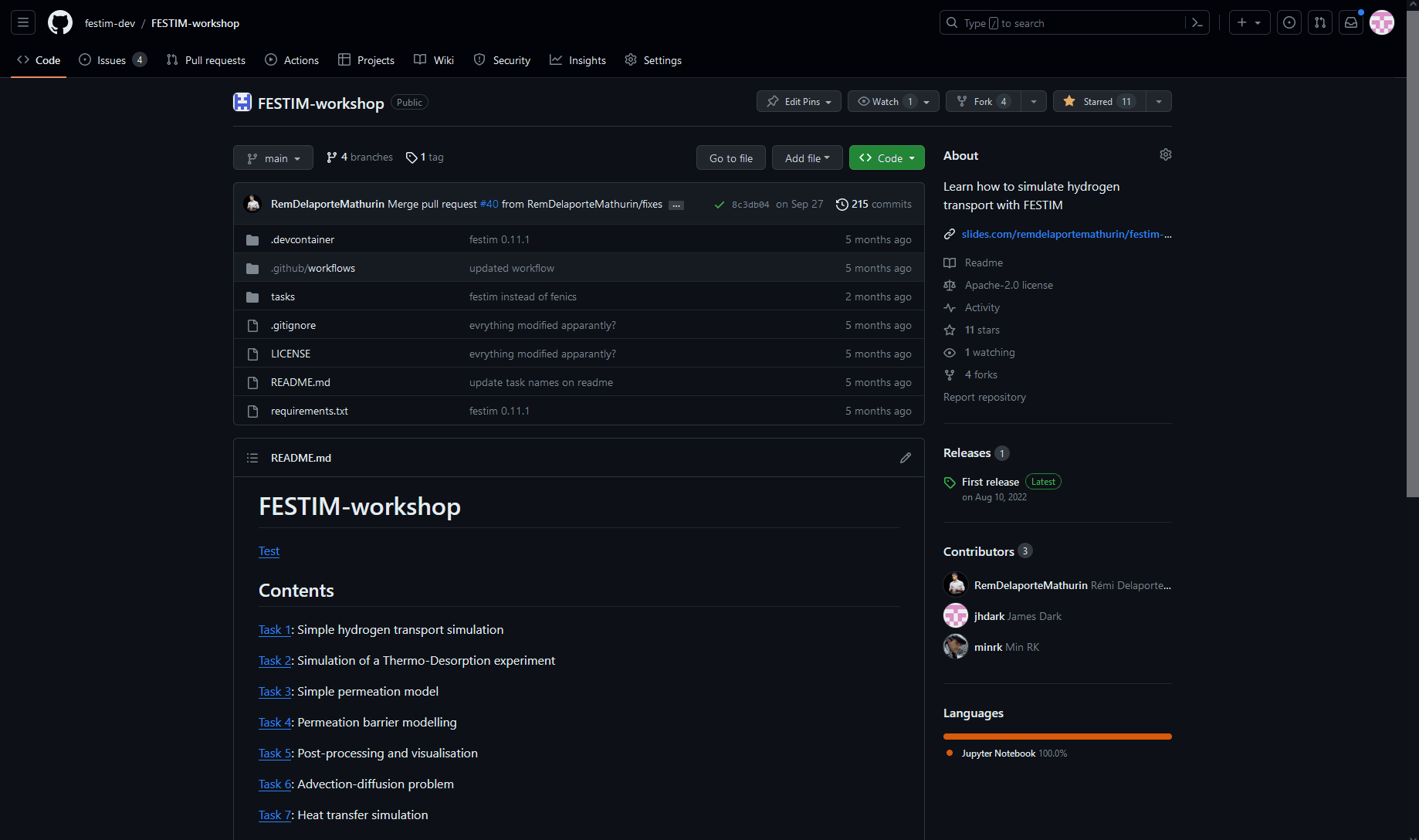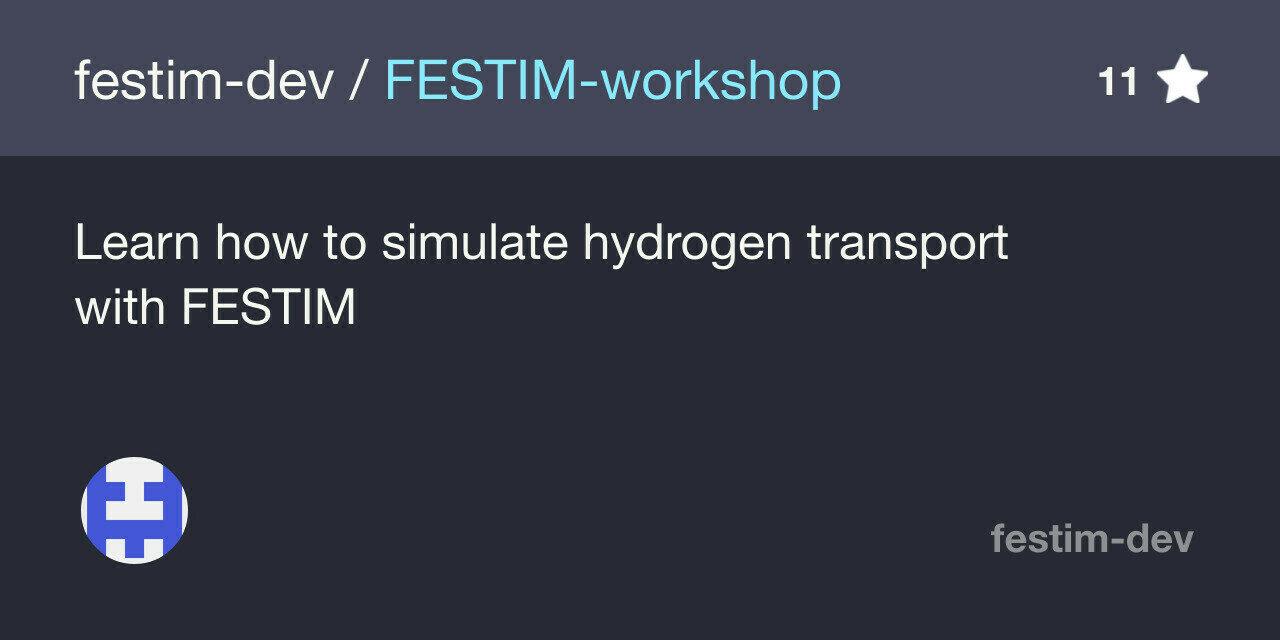H transport modelling with FESTIM
An open-source python-based finite elements code for hydrogen transport

2022
2019
Start of FESTIM development
- 1D/2D/3D
- Finite elements
- Python
- multi-material
- Heat transfer
History of FESTIM
FESTIM open-source
- development continuing at MIT
Oct 2023
v1.0 release
2024

FESTIM
Hydrogen transport
Heat transfer
diffusion and trapping
McNabb & Foster
An open-source python-based finite elements code for hydrogen transport
FESTIM
An open-source python-based finite elements code for hydrogen transport
- Based on the FEniCS library
- Flexible
- Complex geometries
- Very well established library

FESTIM
✅ More transparency
✅ More collaborations
✅ More flexibility
An open-source python-based finite elements code for hydrogen transport

The code is missing a feature?
Just add it!
Found a bug?
Report it and we'll fix it!

📈5 years of development
📑12+ publications
🗣️100+ citations
🧑💻14+ contributors
🏛️20+ institutions using the code
🧑💻27+ Slack members
⭐75+ stars on GitHub
3 workshops
FESTIM in numbers

Evolution of GitHub stars
FESTIM is used worldwide

8 private companies
10 universities
16 research organisations
FESTIM

- Easy to learn
- Plenty of libraries (numpy, scipy, matplotlib, HTM...)
An open-source python-based finite elements code for hydrogen transport
conda install -c conda-forge fenics
pip install festimTwo lines to install!
import festim as F
import numpy as np
my_model = F.Simulation()
my_model.mesh = F.MeshFromVertices(
vertices=np.linspace(0, 1e-6, num=1001)
)
my_model.materials = F.Material(id=1, D_0=1.9e-7, E_D=0.2)
my_model.T = F.Temperature(500) # K
my_model.boundary_conditions = [
F.DirichletBC(
surfaces=[1, 2],
value=1e15, # H/m3/s
field=0
)
]
my_model.settings = F.Settings(
absolute_tolerance=1e10,
relative_tolerance=1e-10,
final_time=100 # s
)
my_model.dt = F.Stepsize(0.1) # s
my_model.initialise()
my_model.run()
Simple simulation
Make use of the python ecosystem
Create a 1D mesh easily
Materials
Temperature
Boundary conditions
Settings and stepsize
Only a few lines of python!
FESTIM is fully documented
Check out the complete documentation at
Installation instructions
User guide
FESTIM's philosophy
We want to make hydrogen transport simulations easy for everyone!
We also encourage contributions!
- Feedback (suggestions, bug reports...)
- Implement new features
- Bug fixing
- Documentation update (even small ones!)
- ...
Gallery of examples
Thermo-desorption



- TDS analysis
- Automated fitting routines
Permeation experiment

No barrier
with barrier
Permeation barrier
Substrate
High H pressure
Low H pressure
Conservation of chemical potential
Permeation flux
Super-permeation

- H is implanted in the first \( 10 \ \mathrm{nm} \)
- Super-permeation regime is attained at high recombination energy (upstream surface)
- Source code

Benedikt & Day, (2017) Fusion Engineering and Design
3D ITER monoblock

- Delaporte-Mathurin et al 2024 International Journal of Hydrogen Energy 63 786–802
- Delaporte-Mathurin et al 2024 Nucl. Fusion 64 026003

- Transient estimation of tritium retention
- Multi-material
- Heat transfer
Influence of ELMs on retention
courtesy of V. Kulagin (MePhi)

- 1D model of a ITER monoblock
- Transient heat transfer simulation
- Varying surface heat flux
Breeding Blanket



courtesy of J. Dark (CEA/LSPM)
- Complex 3D geometry
- Coupled to fluid dynamics
- Tritium generation in the breeder volume
James Dark et al 2021 Nucl. Fusion 61 116076
Neutron-induced trap model

- Custom trap model
- Dynamic evolution of trap densities including annealing
- Parametrised on TDS data from T Schwartz Selinger
courtesy of J. Dark (CEA LSPM)


Tritium extraction system

courtesy of K. Dunnell (MIT)
- Complex 3D geometry
- Coupled with fluid dynamics
- Tritium extraction from permeable membranes

BABY breeding experiment

Velocity
Temperature
Tritium concentration
courtesy of C. Weaver (MIT)

① neutrons are generated
② tritium is created from nuclear reactions
③ tritium is transported in the salt
④ tritium is released into the gas phase
⑤ tritium is collected and counted
Our tritium breeding experiment
Kinetic surface model


courtesy of V. Kulagin (MePhi)
Depleting enclosure
\(P(t)\)
permeation flux
Enclosure

FESTIM is thoroughly tested, verified, and validated
- Validated against TDS, permeation experiments...
- Verified against analytical solutions in many different problems
- Check out FESTIM's V&V book online! (WIP)
festim-vv-report.readthedocs.io

V&V
Effective-diffusion through a slab

2D multi-material
Exact
Computed concentration
Method of Exact Solution
governing equations
exact solutions
parameters (sources, BCs, ICs)
FESTIM
computed solutions
solve
run
compare
⚠️sometimes very complex!
Method of Manufactured Solutions
governing equations
manufactured solutions
source terms, BCs and ICs
FESTIM
computed solutions
compare
FESTIM's development workflow
- Anyone can create their own copy (fork) of the FESTIM repository and make changes
- PRs are a place where FESTIM's maintainers review the proposed changes
- ~500 tests are automatically run
- The PR is only merged when all the tests pass ✅

fork
fork
pull request
FESTIM
Jane Doe
FESTIM
John Doe
FESTIM
festim-dev
pull request
How to use FESTIM


Documentation
and installation instructions
FESTIM workshop

The FESTIM workshop is a series of tutorials
from basic problems to more advance cases

A glimpse into the future
Towards FESTIM2
Core changes
conda install -c conda-forge fenics-dolfinx
pip install git+https://github.com/festim-dev/festim.git@fenicsx- upgrade of the finite element engine →
dolfinx - Better handling of interfaces (WIP)
- Support for multi-species
- Better parallel scalability
- Implementation of
Reaction
You can try this version of FESTIM right now!
New examples
Multi-isotope, multi-level trapping

- 7 different species
- 6 reactions
- \( c_H = 10^{20} \ \mathrm{m^{-3}} \) on the left
- \( c_D = 10^{19} \ \mathrm{m^{-3}} \) on the right
- Source code available here
1 trap, 2 levels, 2 isotopes
\( \mathrm{H} \) = mobile H
\( \mathrm{D} \) = mobile D
\( [\mathrm{H}_x\mathrm{D}_y] \) = \(x\) H and \(y\) D in trap
Isotope swapping


same underlying equations!
Can be represented by festim.Reaction
Isotope swapping
my_model.species = [
mobile_H,
mobile_D,
trapped_H,
trapped_D,
]
my_model.reactions = [
F.Reaction(
k_0=k_0,
E_k=0.39,
p_0=1e13,
E_p=1.2,
reactant1=mobile_H,
reactant2=empty_trap,
product=trapped_H,
volume=my_subdomain,
),
F.Reaction(
k_0=k_0,
E_k=0.39,
p_0=1e13,
E_p=1.2,
reactant1=mobile_D,
reactant2=empty_trap,
product=trapped_D,
volume=my_subdomain,
),
F.Reaction(
k_0=k_0,
E_k=0.1,
p_0=k_0,
E_p=0.1,
reactant1=mobile_H,
reactant2=trapped_D,
product=[mobile_D, trapped_H],
volume=my_subdomain,
),
]Usual trapping reactions
Swapping reaction
4 species are defined
Spherical cavity trapping

see Zibrov and Schmid, NME, 2024
for complete description
- Implementation in FESTIM of the spherical cavity trapping model developed by Zibrov and Schmid
- Custom trapping equations
- Smooth implementation in FESTIM
Anisotropy
- Anisotropic materials can be simulated with very few modifications



Follow the development roadmap

H transport modelling with FESTIM
By Remi Delaporte-Mathurin
H transport modelling with FESTIM
- 840






